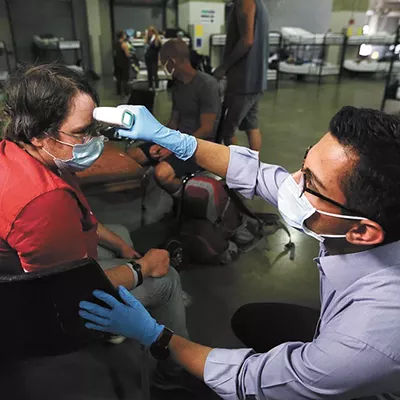Heralded nationally as a model for state-run health insurance exchanges, Washington Healthplanfinder now has a blemish on an otherwise impressive performance record after boasting high enrollment numbers and a smoothly running website in its first three weeks.
Washington is one of 14 states running its own insurance exchange. Its online marketplace, Washington Healthplanfinder, has performed remarkably well, in stark contrast to the botched launch of the federal government's HealthCare.gov. Despite several opening-day glitches that forced exchange officials to take down the site shortly after it debuted Oct. 1, Washington Healthplanfinder has since reported the highest enrollment figures in the country, prompting an effusive evaluation from the Washington Post's Sarah Kliff, who concluded the site "is what it looks like when Obamacare works."
But on Friday, officials announced that a "system error" caused some 8,000 people who applied for private insurance plans through the exchange website to receive overestimated tax credit amounts. The glitch means affected applicants will have to pay between pennies and hundreds of dollars a month more for their premiums than they'd thought.
Reached over the phone, Michael Marchand, communications director at the Washington Health Benefit Exchange, was audibly frustrated with the website's most recent setback.
"We're really disappointed because we expect more of ourselves, and we expect to deliver more for the consumers here in the state, and we want to ensure they all have access to quality health plans," Marchand says. "It's unacceptable that this has happened, but we're really glad we were able to fix it."
The "system error" causing the website to inaccurately compute tax subsidies came to down a missing multiplier of 12. Complex health insurance exchange sites, such as Washington's, pull data from the central Federal Data Services Hub, which in turn transmits information from multiple different federal agencies to help determine coverage eligibility and financial assistance. When Washington consumers entered their monthly income into the Healthplanfinder website, the federal hub was expecting an annual amount, and as result, miscalculated the subsidy.
The glitch, which Marchand says was originally reported within the first 10 days of the marketplace's operation and identified definitively last week, was corrected within 24 hours. Marchand says the exchange "is not taking the time to drill down to see who's at fault," be it site developer Deloitte, the feds or the exchange. Exchange officials haven't decided what kind of fix they'll implement for the 8,000 affected applicants, but they'll contact them by mail or phone soon.
"Ultimately, at the end of the day we're going to be graded on how well the website works, and we're still improving that," Marchand concedes.
In Washington, more people have enrolled in exchange-based health plans than in any other state currently reporting enrollment figures. As of Oct. 25, nearly 50,000 people have purchased health insurance through Washington Healthplanfinder since the first of the month — 6,390 of whom have enrolled in private plans, the rest in Medicaid. Another 52,000 have completed applications for enrollment, but have yet to submit their first payment, due in late December. DJ Wilson, president of Wilson Strategic Communications and host of the State of Reform Health Policy Conference, says he expects applications will spike in December as people's insurance policies expire at the end of the month.
"HIT [health information technology] implementations are always ugly and painful and difficult, so this is no exception," Wilson says. He points to the 2003 error-ridden rollout of the Medicare Part D prescription drug program under President George W. Bush, which current House Speaker John Boehner called "horrendous" seven years ago.
While the problems plaguing HealthCare.gov risk consumer rejection, Wilson doesn't think Washington's glitch will depress future enrollment numbers. "It is a really big deal," he says, "but for most people who are trying to determine whether or not they'll have health insurance for the first time ever, it's not going to get in the way of their enrollment."
By another measure, interest in Washington Healthplanfinder is obviously strong. One of biggest complaints Marchand currently hears involves wait times to the exchange's call center, where customer service representatives are overwhelmed with calls, receiving on average 6,000 a day, sometimes up to 10,000. The exchange is hiring an additional 145 people to handle the call volume.
It's this sustained interest that Marchand says has allowed the exchange to identify problems with the website early. Washington has data from tens of thousands of applicants seeking affordable healthcare coverage; other states with far fewer enrollment numbers just don't.
"If you don't have enrollment and you can't see patterns, you may not know this is an issue," he says. "The silver lining is because of our volume, we were at least able to get in front of it, solve it and fix it within the first three weeks."♦
In Idaho
After two years of debate, Idaho lawmakers voted to build their own state-run exchange in March, but, facing time constraints, have allowed the federal government to run its IT platform.
Ahead of the Pack
How do Washington's enrollment numbers stack up against those from other states?
Washington: 48,995 enrolled through Oct. 25. Uninsured and eligible population: 835,271
New York: 37,030 enrolled through Oct. 23. Uninsured and eligible population: 1,915,217
Kentucky: 26,174 enrolled through Oct. 24. Uninsured and eligible population: 622,054
Connecticut: 3,847 enrolled through Oct. 15. Uninsured and eligible population: 242,738
Maryland: 3,186 enrolled through Oct. 23. Uninsured and eligible population: 480,528
Rhode Island: approx. 2,000 enrolled in first two weeks. Uninsured and eligible population: 100,952
Vermont: approx.1,400 enrolled through Oct. 24. Uninsured and eligible population: 44,104

























